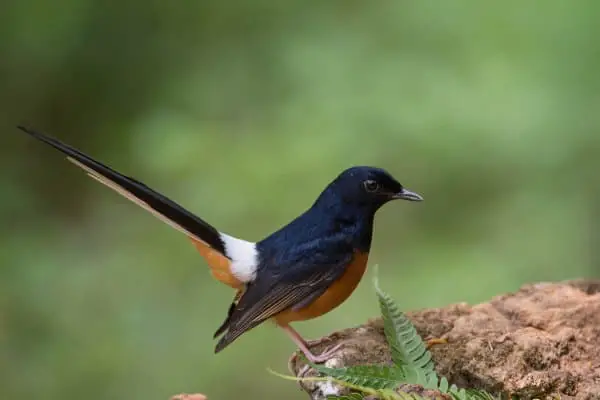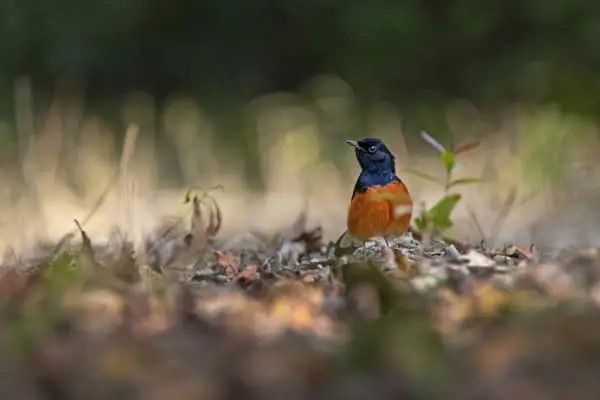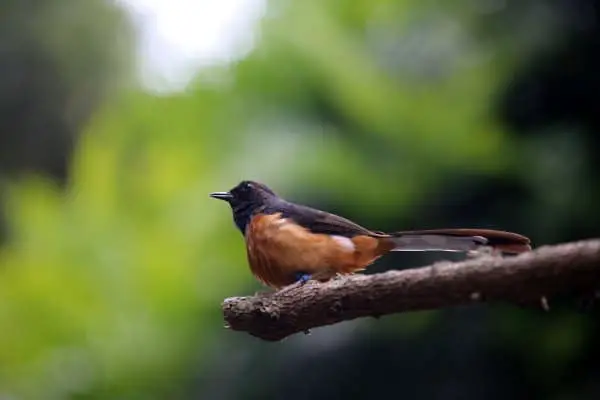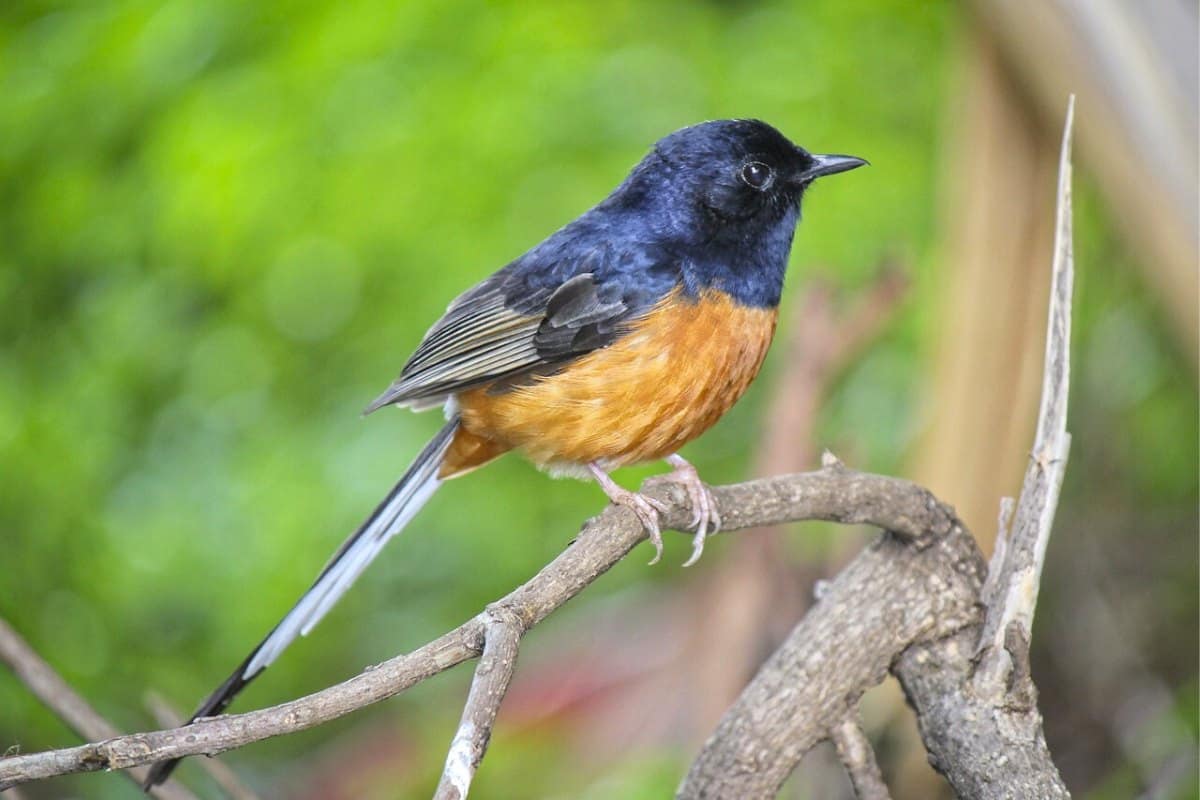Common Name: White-rumped Shama
Scientific Name: (Copsychus malabaricus)| Size | Diet | Range in Hawaii | Status in Hawaii |
|---|---|---|---|
| 8 in. - 10 in. | insects and fruits | Kaua'i, O'ahu, Ni'ihau, Moloka'i, and Lana'i | Least Concern |
The White-rumped Shama, also known as Copsychus malabaricus, is a songbird species that is native to South and Southeast Asia. While the species is not native to Hawaii, it has been long established and is considered a naturalized (non-native) resident of the islands. With its beautiful appearance and enchanting song, the White-rumped Shama is a fascinating bird species that has captured the attention of birdwatchers and avian enthusiasts around the world.
In this article, we will explore the world of the White-rumped Shama, its unique characteristics, and its presence in Hawaii.
White-rumped Shama
Appearance

The White-rumped Shama boasts an elegant appearance with a striking contrast of colors. This bird showcases glossy black plumage on its head, throat, and upperparts, creating a dramatic backdrop for its signature feature: a pure white rump.
Its chest and belly are a warm rust-brown hue, adding to its visual allure. With a length of about 8 to 10 inches (20 to 25 cm), this avian gem combines compact size with a captivating color palette that sets it apart in any environment.
Diet
The White-rumped Shama embraces a diverse and omnivorous diet that mirrors its vibrant personality. With an appetite for both insects and fruits, it navigates its ecosystem with culinary finesse. Its menu includes a range of delectable offerings: from juicy berries to small insects like beetles, ants, and caterpillars.
Nesting
With an artistic touch that rivals the most skilled craftsman, this bird species meticulously weaves its nest into the fabric of nature. Using an assortment of twigs, leaves, and feathers, the White-rumped Shama crafts a symphony of materials to create a cozy haven for its young.
Hidden away in the verdant embrace of the forest, the nest becomes a theater of life’s drama. The male Shama proudly presents this masterpiece to potential mates, demonstrating not only his construction prowess but also his commitment to nurturing future generations. As the female inspects the abode, a bond forms, setting the stage for a partnership that goes beyond the ordinary.
Amidst the dappled sunlight and rustling leaves, the nest resonates with the songs of the male Shama, transforming the surroundings into a melodious haven. The male’s enchanting notes echo through the foliage, a serenade that not only expresses his love but also serves as a timeless invitation to witness the circle of life unfolds.
Behavior

Known for its audacious vocalizations, the male Shama takes center stage during the breeding season. Perched atop a prominent branch, it unleashes a symphony of calls that reverberate through the woods as if telling tales of ancient forests and forgotten legends. With each note, it proclaims its territory and allures potential mates, showcasing a flair for both defense and courtship.
Equally adept at mimicry, the White-rumped Shama morphs into a vocal chameleon, incorporating snippets of other bird songs and natural sounds into its repertoire. It’s as if the forest itself has found a voice through this masterful mimic, giving its environment an enchanting audio scape.
But this avian virtuoso isn’t limited to sound alone. Its graceful antics involve a choreography of courtship displays that rival the elegance of ballet. The male Shama adorns itself with vibrant plumage, fluttering and bowing in a display that exudes both confidence and vulnerability. These dances are more than just rituals; they are living art forms that tell tales of longing, connection, and commitment.
Once the courtship has culminated in partnership, the White-rumped Shama showcases its nurturing side. As a devoted parent, it tends to its offspring with meticulous care. From building a meticulously crafted nest to gathering insects for its hungry brood, the Shama embodies the essence of parental dedication.
Habitat

This captivating bird has chosen its residence carefully, often favoring the edges of dense forests, clearings embellished with shrubs, and the fringes of woodlands that straddle the line between light and shadow. Water sources, such as streams or ponds, are an integral part of this habitat.
Range
The White-rumped Shama, native to South India, Sri Lanka, Southeast Asia, and Western Indonesia, is a melodious bird known for its captivating song. Despite its native range, the species has also been introduced to the Southeastern Hawaiian Islands, including Kaua’i, O’ahu, Ni’ihau, Moloka’i, and Lana’i. While the species has faced fluctuations in population density on various islands, it remains a distinctive and cherished part of Hawaii’s avian landscape.
Conservation Status
The White-rumped Shama is listed as a species of “Least Concern” by the International Union for Conservation of Nature (IUCN) in the past, but recent trends have cast a shadow of uncertainty. The delicate balance between its lush habitat and human development has tilted, raising concerns about its future.
Interesting Facts
1. Fairy tale origins
In some cultures, the White-rumped Shama has been associated with folklore and mythology. Its striking appearance and beautiful song have inspired stories and legends across its range.
2. Distinctive white rump
As the name suggests, the White-rumped Shama has a prominent white patch on its lower back, which is especially noticeable during flight. This unique feature sets it apart from other bird species.
3. Artistic territory marking
Male White-rumped Shamas engage in “wing-flashing,” a behavior where they rapidly fan their wings while singing. This visual display complements their vocal performance, reinforcing their territorial claims.
4. Intricate preening
Preening, the act of cleaning and maintaining feathers, is crucial for a bird’s health. White-rumped Shamas are meticulous preeners, using their beaks to carefully arrange and groom their feathers to keep them in optimal condition.
5. Cultural symbolism
In some cultures, the White-rumped Shama holds special significance. For example, it is considered a sacred bird in Bali, Indonesia, and features in traditional art and rituals.
Frequently Asked Questions
1. Can the White-rumped Shama be kept as a pet?
The White-rumped Shama’s captivating song and appearance make it sought after as a pet. However, it’s important to note that capturing and keeping wild birds as pets can have detrimental effects on their wild populations. In some areas, keeping them as pets may also be illegal due to conservation concerns.
2. How long does the White-rumped Shama live?
The lifespan of a White-rumped Shama in the wild can vary, but they typically live around 7 to 10 years. In captivity, they might live longer due to the absence of natural predators and access to consistent food and care.
3. How does the White-rumped Shama contribute to ecosystem balance?
As an insectivore, the White-rumped Shama plays a role in controlling insect populations, which helps maintain the balance of ecosystems. By consuming insects, it indirectly contributes to plant health and supports the food web.
4. How can people help conserve the White-rumped Shama?
Individuals can contribute to the conservation of the White-rumped Shama by supporting habitat protection efforts, avoiding capturing wild birds for pets, raising awareness about its importance, and supporting conservation organizations working to safeguard its populations.




